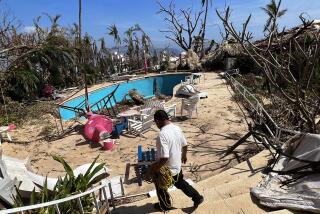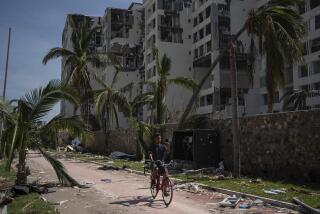Hurricanes strike both Latin American coasts
Hurricane Felix came ashore on Nicaragua’s remote Miskito Coast early Tuesday as a Category 5 storm, damaging about 5,000 homes in the region before moving westward toward the heart of this country of 7 million people, officials said.
Less than nine hours later and more than 1,600 miles away in the Pacific, a second and much weaker hurricane, Henriette, struck the resort city of San Jose del Cabo on the southern tip of Baja California, Mexico.
Henriette’s center reached the Baja mainland after 1 p.m. Tuesday about six miles east of San Jose del Cabo’s downtown.
It was the first time Atlantic and Pacific hurricanes had made landfall on the same day since the U.S. National Hurricane Center began keeping records in 1949, according to the Associated Press.
Felix packed 160-mph winds as it made landfall, but quickly lost power and was downgraded to a tropical storm as it advanced over the sparsely populated mountains along the Nicaraguan-Honduran border. The storm nonetheless threatened to cause severe flooding as it passed near Tegucigalpa, the Honduran capital. In Nicaragua, officials said 5,500 structures had been damaged in Puerto Cabezas and other coastal cities. At least three people were killed. Honduran and Nicaraguan officials had evacuated thousands of tourists and residents from seaside towns all along the Miskito Coast, also known as the Mosquito Coast, beginning Monday.
As many as 60,000 tourists, most of them from the United States, remained in the resorts at the southern tip of Baja California as Henriette approached, Mexican officials said.
Angel Marquez Cervantes, chief of staff to the city government in Cabo San Lucas, said officials there had begun mandatory evacuations of 2,000 people from hotels and low-lying city neighborhoods.
“We had some problems because a lot of people didn’t want to leave their houses,” Marquez Cervantes said in a telephone interview. “But when we’re on red alert, we evacuate them whether they want to or not. We’d rather they be angry with us, but safe.”
In Honduras, authorities warned of severe flooding and landslides from an anticipated 15 inches of rain. Hurricane Mitch was also a weakened storm when it passed through central Honduras in 1998, setting off floods and landslides that killed thousands. But Felix was expected to pass through the country relatively quickly.
“Thanks to God . . . the hurricane is entering in the least populated areas of Honduras, which are areas of forests and farmland,” Honduras President Manuel Zelaya said Tuesday morning at a news conference. “God willing, it will lose force as it crosses the Segovia mountains of Nicaragua.”
Several hours later, the president said that Felix was less of a threat, though it still could cause severe flooding as it passed near the capital.
Honduran officials declared a “red alert” in Tegucigalpa, home to more than 1 million people. Dozens of gasoline stations ran out of fuel as people filled tanks. City officials said they were ordering mandatory evacuations in some neighborhoods.
Officials at the U.S. National Hurricane Center in Miami said Felix would “likely produce life-threatening flash floods and mudslides.”
Thousands of Miskito Indians in the region declined to be evacuated ahead of the storm. Nicaraguan officials said at least one person had been killed on Cayos Miskitos, an island 25 miles from the mainland.
In a nationally televised address, Nicaraguan Cardinal Miguel Obando y Bravo called on his countrymen to pray “for our brothers on the Caribbean.”
“We Nicaraguans have, historically, faced the violence of nature, and we’ve done so with solidarity and a sense of resignation,” Obando y Bravo said.
On Honduras’ northern coast, which escaped the brunt of the storm, many expressed relief.
“I was nervous, but I was prepared,” said Filiberto Martinez, a resident of San Pedro Sula, about 20 miles inland. “But God was with us. And of course we’re happy.”
Felix was the second Category 5 hurricane to make landfall in Latin America this season. Hurricane Dean struck Mexico’s Yucatan peninsula last month.
President Zelaya of Honduras said he feared serious damage to the country’s corn crop, which had been expected to be the largest harvest in many years.
Mexican President Felipe Calderon, speaking in the southern state of Chiapas, blamed climate change for increasing the power of hurricanes and deforestation for increasing the damage they cause.
“It’s sad that these things happen in large measure because of the damage we humans have inflicted on nature,” Calderon said.
In Cabo San Lucas, officials worried about the effect on tourism.
Marquez Cervantes said the region’s tourists were safe. But he and others were concerned that a direct hit on the city might hurt the tourist trade.
“Here we depend 100% on tourism,” Marquez Cervantes said. “If it hits us hard, our principle industry could be destroyed.”
--
Special correspondent Renderos reported from San Pedro Sula and Times staff writer Tobar from Mexico City. Cecilia Sánchez and Maria Antonieta Uribe of The Times’ Mexico City Bureau contributed to this report.
More to Read
Start your day right
Sign up for Essential California for news, features and recommendations from the L.A. Times and beyond in your inbox six days a week.
You may occasionally receive promotional content from the Los Angeles Times.







